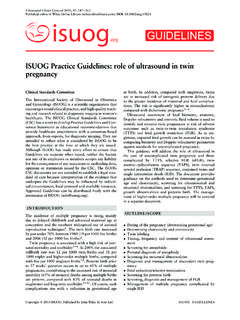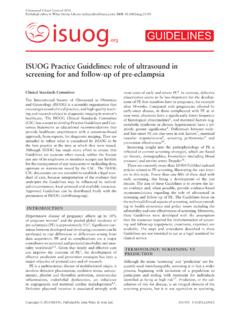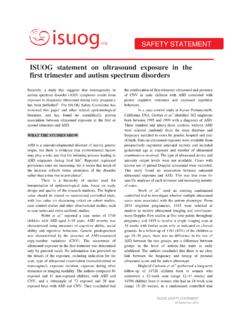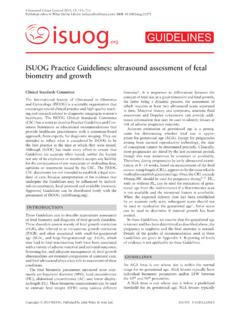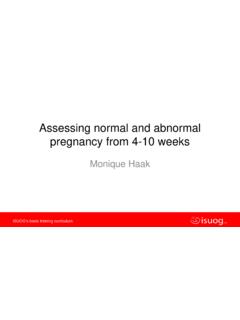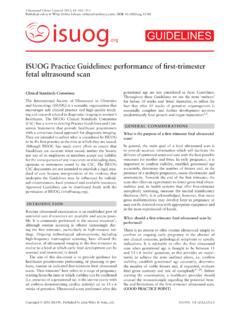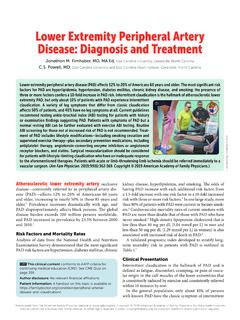Transcription of ISUOG Practice Guidelines: performance of firsttrimester ...
1 Ultrasound Obstet Gynecol2013;41: 102 113 Published online in Wiley Online Library ( ). Practice guidelines : performance of first-trimesterfetal ultrasound scanClinical Standards CommitteeThe International society of Ultrasound in Obstetricsand Gynecology ( ISUOG ) is a scientific organization thatencourages safe clinical Practice and high-quality teach-ing and research related to diagnostic imaging in women shealthcare. The ISUOG Clinical Standards Committee(CSC) has a remit to develop Practice guidelines and Con-sensus Statements that provide healthcare practitionerswith a consensus-based approach for diagnostic are intended to reflect what is considered by ISUOGto be the best Practice at the time at which they are ISUOG has made every effort to ensure thatGuidelines are accurate when issued, neither the Societynor any of its employees or members accept any liabilityfor the consequences of any inaccurate or misleading data,opinions or statements issued by the CSC.
2 The ISUOGCSC documents are not intended to establish a legal stan-dard of care because interpretation of the evidence thatunderpins the guidelines may be influenced by individ-ual circumstances, local protocol and available guidelines can be distributed freely with thepermission of ISUOG ultrasound examination is an established part ofantenatal care if resources are available and access possi-ble. It is commonly performed in the second trimester1,although routine scanning is offered increasingly dur-ing the first trimester, particularly in high-resource set-tings. Ongoing technological advancements, includinghigh-frequency transvaginal scanning, have allowed theresolution of ultrasound imaging in the first trimester toevolve to a level at which early fetal development can beassessed and monitored in aim of this document is to provide guidance forhealthcare practitioners performing, or planning to per-form, routine or indicated first-trimester fetal ultrasoundscans.
3 First trimester here refers to a stage of pregnancystarting from the time at which viability can be confirmed( presence of a gestational sac in the uterine cavity withan embryo demonstrating cardiac activity) up to 13+6weeks of gestation. Ultrasound scans performed after thisgestational age are not considered in these these guidelines we use the term embryo for before 10 weeks and fetus thereafter, to reflect thefact that after 10 weeks of gestation organogenesis isessentially complete and further development involvespredominantly fetal growth and organ maturation2, CONSIDERATIONSWhat is the purpose of a first-trimester fetal ultrasoundscan?In general, the main goal of a fetal ultrasound scan isto provide accurate information which will facilitate thedelivery of optimized antenatal care with the best possibleoutcomes for mother and fetus. In early pregnancy, it isimportant to confirm viability, establish gestational ageaccurately, determine the number of fetuses and, in thepresence of a multiple pregnancy, assess chorionicity andamnionicity.
4 Towards the end of the first trimester, thescan also offers an opportunity to detect gross fetal abnor-malities and, in health systems that offer first-trimesteraneuploidy screening, measure the nuchal translucencythickness (NT). It is acknowledged, however, that manygross malformations may develop later in pregnancy ormay not be detected even with appropriate equipment andin the most experienced of should a first-trimester fetal ultrasound scan beperformed?There is no reason to offer routine ultrasound simply toconfirm an ongoing early pregnancy in the absence ofany clinical concerns, pathological symptoms or specificindications. It is advisable to offer the first ultrasoundscan when gestational age is thought to be between 11and 13+6 weeks gestation, as this provides an oppor-tunity to achieve the aims outlined above, confirmviability, establish gestational age accurately, determinethe number of viable fetuses and, if requested, evaluatefetal gross anatomy and risk of aneuploidy4 the examination, a healthcare provider shouldcounsel the woman/couple regarding the potential bene-fits and limitations of the first-trimester ultrasound scan.
5 (GOOD Practice POINT)Copyright 2013 ISUOG . Published by John Wiley & Sons, S U O G G U I D E L I N E SISUOG Guidelines103 Who should perform the first-trimester fetal ultrasoundscan?Individuals who perform obstetric scans routinely shouldhave specialized training that is appropriate to the practiceof diagnostic ultrasound for pregnant women.(GOODPRACTICE POINT)To achieve optimal results from routine ultrasoundexaminations it is suggested that scans should be per-formed by individuals who fulfill the following criteria:1. have completed training in the use of diagnostic ultra-sonography and related safety issues;2. participate in continuing medical education activities;3. have established appropriate care pathways for suspi-cious or abnormal findings;4. ultrasonographic equipment should be used?It is recommended to use equipment with at least thefollowing capabilities: real-time, gray-scale, two-dimensional (2D) ultrasound; transabdominal and transvaginal ultrasoundtransducers; adjustable acoustic power output controls with outputdisplay standards; freeze frame and zoom capabilities; electronic calipers; capacity to print/store images; regular maintenance and should the scan be documented?
6 An examination report should be produced as an elec-tronic and/or paper document (see Appendix for anexample). Such a document should be stored locally and,in accordance with local protocol, made available tothe woman and referring healthcare provider.(GOODPRACTICE POINT)Is prenatal ultrasonography safe during the firsttrimester ?Fetal exposure times should be minimized, using the short-est scan times and lowest possible power output needed toobtain diagnostic information using the ALARA (As LowAs Reasonably Achievable) principle. (GOOD PRAC-TICE POINT)Many international professional bodies, includingISUOG, have reached a consensus that the use of B-mode and M-mode prenatal ultrasonography, due to itslimited acoustic output, appears to be safe for all stages ofpregnancy22,23. Doppler ultrasound is, however, associ-ated with greater energy output and therefore more poten-tial bioeffects, especially when applied to a small region ofinterest24,25.
7 Doppler examinations should only be used inthe first trimester, therefore, if clinically indicated. Moredetails are available in the ISUOG Safety if the examination cannot be performed inaccordance with these guidelines ?These guidelines represent an international benchmarkfor the first-trimester fetal ultrasound scan, but consider-ation must be given to local circumstances and medicalpractices. If the examination cannot be completed inaccordance with these guidelines , it is advisable to doc-ument the reasons for this. In most circumstances, it willbe appropriate to repeat the scan, or to refer to anotherhealthcare practitioner. This should be done as soon aspossible, to minimize unnecessary patient anxiety andany associated delay in achieving the desired goals of theinitial examination.(GOOD Practice POINT)What should be done in case of multiple pregnancies?Determination of chorionicity and amnionicity is impor-tant for care, testing and management of multifetal preg-nancies.
8 Chorionicity should be determined in early preg-nancy, when characterization is most reliable26 is accomplished, further antenatal care, including thetiming and frequency of ultrasound examinations, shouldbe planned according to the available health resourcesand local guidelines . (GOOD Practice POINT) guidelines FOR EXAMINATION1. Assessment of viability/early pregnancyIn this Guideline, age is expressed as menstrual or ges-tational age, which is 14 days more than conceptionalage. Embryonic development visualized by ultrasoundclosely agrees with the developmental time schedule of human embryos described in the Carnegie stagingsystem3. The embryo is typically around 1 2 mm longwhen first detectable by ultrasound and increases in lengthby approximately 1 mm per day. The cephalic and caudalends are indistinguishable until 53 days (around 12 mm),when the diamond-shaped rhombencephal cavity (futurefourth ventricle) becomes viabilityThe term viability implies the ability to live indepen-dently outside the uterus and, strictly speaking, cannot beapplied to embryonic and early fetal life.
9 However, thisterm has been accepted in ultrasound jargon to mean thatthe embryonic or fetal heart is seen to be active and this istaken to mean the conceptus is alive . Fetal viability, froman ultrasound perspective, is therefore the term used toconfirm the presence of an embryo with cardiac activity atthe time of examination. Embryonic cardiac activity hasbeen documented in normal pregnancies at as early as 37days of gestation29, which is when the embryonic hearttube starts to beat30. Cardiac activity is often evidentwhen the embryo measures 2 mm or more31, but is notevident in around 5 10% of viable embryos measuringbetween2and4mm32, 2013 ISUOG . Published by John Wiley & Sons, Obstet Gynecol2013;41: 102 GuidelinesDefining an intrauterine pregnancyThe presence of an intrauterine gestational sac clearlysignifies that the pregnancy is intrauterine, but the cri-teria for the definition of a gestational sac are use of terms such as an apparently empty sac, the double-decidual ring or even pseudosac do not accu-rately confirm or refute the presence of an intrauterinepregnancy.
10 Ultimately, the decision is a subjective oneand is, therefore, influenced by the experience of theperson performing the ultrasound examination. In anasymptomatic patient, it is advisable to wait until theembryo becomes visible within the intrauterine sac as thisconfirms that the sac is indeed a gestational sac.(GOODPRACTICE POINT)2. Early pregnancy measurementsThe mean gestational sac diameter (MSD) has beendescribed in the first trimester from 35 days from thelast menstrual period onwards. The MSD is the averageof the three orthogonal measurements of the fluid-filledspace within the gestational sac34. Nomograms for bothcrown rump length (CRL) and MSD are available, but,in the presence of the embryo, the CRL provides a moreaccurate estimation of gestational age because MSD valuesshow greater variability of age prediction35, First-trimester fetal measurementsWhich measurements should be performed in the firsttrimester ?

